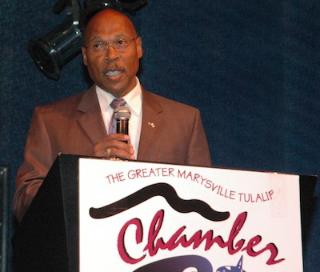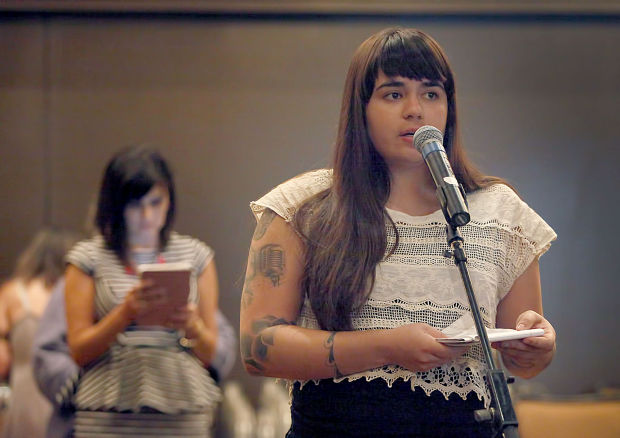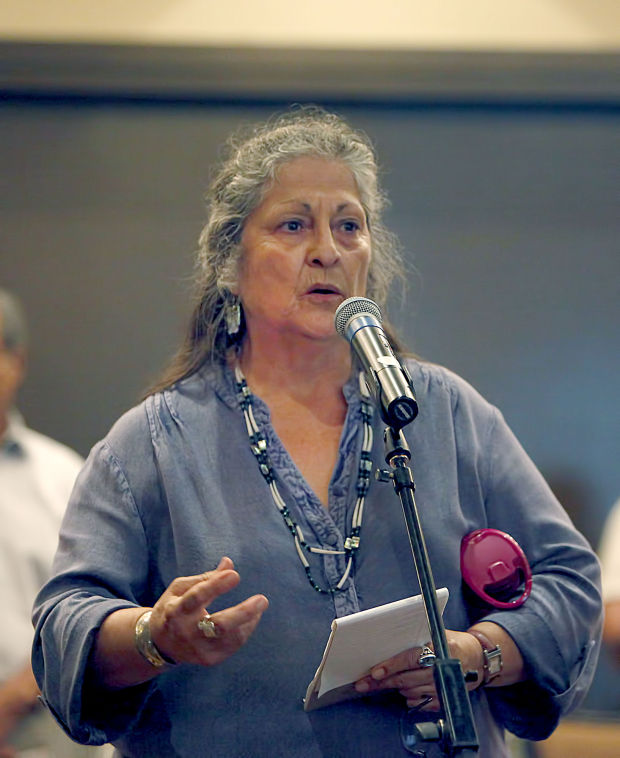
Snohomish County Executive John Lovick addresses the Greater Marysville Tulalip Chamber of Commerce during its Business Before Hours on July 26.
Kirk Boxleitner, Marysville Globe
TULALIP — “Jobs, jobs, jobs” was how John Lovick described his focus to the Greater Marysville Tulalip Chamber of Commerce on Friday, July 26, but during the Chamber’s Business Before Hours meeting that morning, the recently appointed Snohomish County Executive also recalled examples of leadership from his own life, as he told the Chamber members that they were the leaders of their community.
“I never in a million years thought I’d be the County Executive,” said Lovick, who cited the significant legacies that his predecessors have established in that role. “I’m not Willis Tucker, or Bob Drewel, or Aaron Reardon, but I will do my absolute best for you. Snohomish County is a tremendously great place to live, work and play, and it has become home to me. Everything in the world that you could want is right here.”
Rather than referring to the unemployment rate, Lovick noted that the county has an employment rate of 95.3 percent, and while he deemed this a statistic to be proud of, he also pledged to personally promote more jobs for county citizens.
“We have a right to be happy with where we are, but we shouldn’t be pleased until everyone who wants a job in this county has one,” Lovick said. “We should be talking about jobs every single day. We can’t expect others to support us if we don’t do it ourselves.”
After praising Marysville Police Chief Rick Smith during his opening remarks, Lovick went on to commend the dedication and talent of all the city and county officials in Snohomish County, describing its city councils in particular as “the foot-soldiers of democracy.”
Not only did Lovick pledge that the Snohomish County Executive’s Office would operate with integrity, but the former County Sheriff and Washington State Patrol trooper also offered examples of what he saw as demonstrations of integrity from his past, including his run for the Mill Creek City Council in 1993.
“I was only 22 years removed from growing up in segregated Louisiana, and I didn’t see a lot of people here who looked like me,” said Lovick, whose son wanted him to run for office in Mill Creek. “But my son said that he’d never heard me say that he couldn’t do anything he set out to do, which shows that kids actually listen to what you tell them. So I filed for the Mill Creek City Council Position 2 seat, and I went door-to-door to every house in town, five times each. By the fourth time, one man told me that he’d already voted for me and asked me not to come back,” he laughed.
Lovick went on to win 65 percent of the vote in that race, which he deemed pretty good for a man who had never planned to be a politician before then.
“I talk to young people all the time, and tell them to dream beyond what they believe they can do,” Lovick said. “I don’t think most people fail because they set their goals too high.”
After he was honorably discharged from the Coast Guard, Lovick’s next goal was to become a state trooper, which was no mean feat given that, in his estimation, academy classes back then only accepted one black cadet each. However, in the mid-1970s, Lovick beat the odds by being one of three black cadets in his academy class of 35.
“That was one of the best classes in the history of that academy,” Lovick said, touting the number of his fellow cadets who went on to high-profile roles in law enforcement. Their instructor, Jerry Baxter, asked all three black cadets to stand, and defended their worthiness to wear the uniform to their classmates. “Years later, when I asked him about it, he explained his actions with the words ‘integrity’ and ‘cowardice.’ He’d seen previous cadets come and go, and he knew they were qualified, but he’d done nothing when he heard people talking about them. To his mind, someone had to protect the integrity of the process.”
Within his first 53 days as County Executive, Lovick has sought to uphold this standard of integrity by telling his office staff that, “If you see that we’re doing something improperly, or if I ask you to do anything illegal, unethical or immoral, you have my permission to go to the next level to report it.”
Lovick deemed the leadership of the Chamber members in attendance to be at least as important as his own to the well-being of the county as a whole.
“All of you are leaders, or you wouldn’t be in this room,” Lovick said. “And your leadership attracts jobs. We want businesses to want to relocate here and stay here.”
Contact Marysville Globe Reporter Kirk Boxleitner at kboxleitner@marysvilleglobe.com or 360-659-1300 Ext. 5052.

















